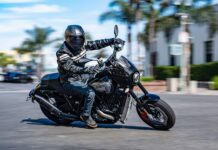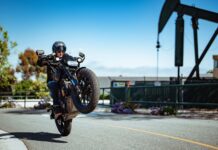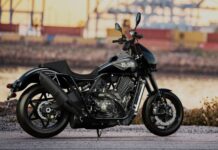Mile-mannered and dressed to thrill
A fine balance of form and function
The much-ballyhooed affiliation between Victory Motorcycle and the Family Ness dates back to 2001, and over that time span the participation of Arlen, son Cory and, more recently, grandson Zach has been almost entirely in an advisory capacity with one major exception, their hands-on creation of exclusive Ness Signature Series customizations each model year since 2004. For the past five years, Cory has put his own stamp on the Victory Vegas Jackpot, the company’s fat-tired boulevard cruiser, but for 2011 he’s bucked that trend and turned his considerable talents to instead tricking out the distance-touring Cross Country model, and I couldn’t be happier about it. I say that for selfish reasons. On the one hand I’m a devout bagger fancier who prizes touring acumen above all other two-wheeled attributes, and I’d be riding the new model from the 2011 Victory press launch in southwest Colorado to Sturgis, there to dwell for the duration of the rally with the bike as my means of transportation. And on the other hand, I’ve got a vain streak that would be well indulged by riding around the rally region on a truly unique head-turner of a machine, and one that had yet to be widely viewed by the motorcycling public.
The underlying Cross Country model upon which Cory applied his artistry debuted last year to near-universal acclaim, in some measure because, in concert with its more minimalist sibling, the Cross Roads, it filled nicely a pivotal slot in the Victory line-up—a slot previously occupied unconvincingly by the retired Kingpin Tour—between the company’s existing line-up of street-dedicated cruisers and their outré luxo-tourer, the Vision. The Cross Country employs the same essential cast-aluminum backbone chassis architecture as the Vision, but you’d scarcely know it by its looks. Though similarly proportioned in its placement of powertrain, suspension and seating, the Cross Country breaks sharply from the Vision’s controversial take on moto-futurism, opting instead for outfitting that hews more closely to conventional bagger appearances—so much so, in fact, that even the initially suspect use of unusual flat-sided forged crashbars quickly becomes an aesthetic nonissue. It’s an instantly likable look with angular art-deco styling cues and lavishly sculpted and faceted bodywork radiating in all directions from the bold Reauleaux-triangular headlight back to the stylized “V” rear light array that I like to call the Gumby crucifix. A visual feast, is what it is, and one that gets even more delicious when given the Cory Ness Sunset Red paint treatment that accentuates every sculpted nuance of the bodywork, and looks, frankly and appropriately, like war paint.
From there the Cory treatment consists of a whole raft of custom accessories and cosmetic details including knurled billet handgrips, foot controls and passenger pegs, chrome operator footboards, custom mirrors, finned engine covers, slotted crashbars, billet Anvil wheels, suede seating surfaces, and dazzling diamond-cut engine fins that bring home the “jewel in the setting” meme that Victory has used for years to describe their motor’s appearance. These departures from stock are superficial enough to wow the eye while leaving the essential touring virtues of the model intact for the most part, the exceptions being the billet grips, which are harder on the hands than the stockers; the billet shifter which is hard on the shoeshine, and the suede seat inserts which are something less than waterproof and can soak up moisture. Wear good gloves, old boots, and cover the seat in the rain and you’ll be all right.
Touring-friendly accoutrements
For the serious touring rider—as well as just the seriously practical daily rider—the Cross Country’s saddlebags are a real pleasure. Their capacity is prodigious and access to that space is utterly unobstructed. Push the button on the top and the lid pops open, hinging outward and making it a simple matter to just drop your stuff inside. It’s truly a one-handed operation which means you don’t have to set things down to manipulate it. The lid closes with a click, though it’s wise to give it a firm push to make sure it’s secure. The bags are lockable and easily removed by twisting a pair of Dzus fasteners on each.
Also appreciated from a packing standpoint is the availability of bungee hook points on the saddlebag’s mounting brackets—a feature Victory models have long been short on. The combination of the saddlebags’ generous capacity and a fat duffle bungeed on the pillion made it possible to haul all of the gear I needed for the 10-day Sturgis trip. Once the bike was off-loaded at my Spearfish lodgings for the rally, those bags did yeoman grocery hauling duty for the duration, and made packing copious camera gear and spare outerwear around the rally an effortless proposition. For those traveling two-up, the Cross Country can be equipped with an optional quick-release trunk introduced this year for this model as well as the Cross Roads.
The Cross Country’s cockpit appointments are equally touring-friendly starting with the wealth of information displayed by the dash panel. An analog speedo, tach, gas gauge and voltmeter flank an easy-to-read digital LCD screen showing the time, temperature, gear selection, fuel range, engine operating data, odometer and tripmeter. A separate screen displays sound system information. Suspended from the hand controls are a pair of perfectly-positioned switch modules with three buttons each, one on the left controlling all sound system functions, and one on the right operating the cruise control. They’re easily readable as well, and easily manipulated with a gauntleted thumb, taking the guesswork out of punching buttons to get what you want.
Wind protection provided by the Cross Country’s fork-mounted fairing is actually better than you’d expect from appearances. The windscreen is a short affair, for sure, being modeled on Harley-Davidson’s Street Glide, the bike with which the Cross Country is unapologetically targeted to compete, but even so it knocks down the breeze adequately enough to keep wind fatigue from becoming a factor on long rides, and even adequately enough to keep the bike’s sound system reasonably audible at highway speeds. (To what extent the optional fork-mounted wind deflectors affixed to the test bike helped in that regard is hard to judge.) It helps some that the operator perch is notched low, a scant 26.5 inches from the pavement. That makes the pillion a decent back support for the rider, but it also means that the seat is somewhat compact by touring standards. Fortunately the machine has immense footboards that permit a lot of boot movement and thus a variety of operator postures. Sitting upright with boots planted rearward on the planks works well for aggressive riding in twisty conditions, while slouching with feet extended all the way forward provides kicked-back comfort for the long haul.
Prowess and power
As competent as the Cross Country is at devouring long highway miles, it’s off rambling on the back roads where it really finds its element. It seems to forget that it’s a fully-fleshed bagger and morphs into a surprisingly agile sport tourer. It displays rock-solid stability with even and predictable steering manners, and for that you can credit that gnarly backbone frame that doesn’t know the meaning of the word flex, as well as an excellent pair of suspenders—well-dialed 43mm inverted cartridge forks with over five inches of travel up front and an air-adjustable rear mono-shock in the rear which provides four inches of travel, a surprisingly long distance given the slammed seat height. Cornering clearance is ample for pretty much any apex wrangling you’re liable to do short of the insane.
Like all 2011 Victory models, the Cross Country is powered by a 106 c.i. Freedom motor with 6-speed overdrive transmission. The touring models get the Stage 1 version of the mill, which produces a claimed 92 horsepower and 109 pounds of torque, and delivers its potent punch with a deceptive civility. Launch it off a stop and rock a couple of gears and you find yourself going real damn fast without really knowing how you got there. It’s that smooth.
Equally civilized is the thoroughly reworked transmission brought to the entire Victory line-up this year. An exhaustive regimen of rethinking, revising, reconfiguring and technical wizardry have resulted in a dramatically improved and user-friendly device, one that eliminates fully two thirds of the previous unit’s driveline lash and extends the service interval to 5,000 miles. Besides bringing an unprecedented slickness to both shifting and notching neutral, the modifications reduced the box’s noise level to the point where more decibels could be allocated to the exhaust note, and thus the mufflers have conspicuously larger exit openings than their predecessors. As a result, the machine now sounds more like a potato and less like a zucchini.
Bottom line
Victory Motorcycle has seen their star rising of late, posting double-digit sales growth in an otherwise contracting marketplace, and that’s due in large part to the reception the Cross Roads and Cross Country models have received. They’re the right bikes at the right time, and they’ve been brought in at attractive price points. The basic Cross Country retails for $17,999, and the Cory Ness version goes for $24,999. For that you get a machine that effectively balances laudable road chops with elegant custom flourishes and a wicked attitude. Well done. Now if they could just figure out a way to put a fork lock on these things.

















